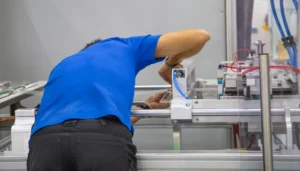Summary: Understanding the mean time to failure (MTTF) is crucial for assessing the reliability and lifespan of non-repairable assets. MTTF represents the average operational time of a system or component before its first failure. Unlike mean time between failure (MTBF), which applies to repairable assets and includes repair times, MTTF specifically focuses on the duration until a failure that can’t be repaired occurs. By calculating MTTF, organizations gain insights into how long they can expect individual units or systems to function reliably before needing replacement.
What is Mean Time to Failure (MTTF)?
MTTF, short for mean time to failure, is a metric used to measure the average time a non-repairable asset operates before it fails. Unlike mean time between failure (MTBF), which is used for repairable assets, Mean Time to Failure focuses on assets that cannot be repaired once they fail. It is a crucial maintenance metric that helps predict the reliability and lifespan of products and systems.
MTTF Calculation
To calculate an asset’s MTTF, you need to collect failure data over a specific period. The Mean Time to Failure value is obtained by dividing the total operating time by the number of failures that occurred during that period. This calculation assumes a constant failure rate, meaning the asset’s failure probability remains relatively steady over time.
To calculate the MTTF of an asset, you need to collect data regarding the operating time of multiple units and the number of failures they experienced. The formula for calculating MTTF is as follows:
MTTF = Total Operating Time / Number of Failures
On the other hand, MTBF is used to measure the average time between two failures for repairable assets. It considers the repair time (MTTR) and is calculated as:
MTBF = Total Operating Time / Number of Failures
While MTBF is widely used, it’s important to note that it may not be suitable for non-repairable assets. In such cases, Mean Time to Failure provides a more accurate representation of the asset’s reliability.
MTTF is calculated by dividing the total operational time of multiple assets by the number of failed assets. This metric helps maintenance programs prioritize resources effectively by predicting when assets might fail and allow to implements the proactive maintenance strategies. A higher MTTF indicates greater reliability and adherence to quality standards, enabling businesses to maintain a healthy maintenance budget and optimize operational efficiency. By using MTTF, organizations can improve their maintenance and reliability practices, ensuring systems operate efficiently over their expected lifespan without unexpected breakdowns.
How MTTF Helps
MTTF plays a vital role in maintenance planning and resource allocation. By knowing the average time an asset operates without failure, maintenance teams can schedule maintenance activities more efficiently. It allows them to proactively address potential issues, reducing unexpected failures and minimizing downtime.
Using MTTF to Improve Reliability
Tracking MTTF
Organizations can leverage computerized maintenance management system (CMMS) software to use MTTF effectively. By tracking the Mean Time to Failure of individual assets, maintenance teams can identify patterns and trends in failure rates. This data helps them make informed decisions regarding maintenance procedures, replacement parts, and asset management.
Increasing MTTF
There are several ways to improve MTTF and enhance overall reliability:
1. Implement Preventive Maintenance
Regular preventive maintenance can extend the lifespan of assets and reduce the likelihood of unexpected failures. Organizations can identify and address potential issues by adhering to maintenance schedules and performing necessary inspections before they lead to failures.
2. Optimize Maintenance Strategies
Analyzing Mean Time to Failure data allows organizations to optimize their maintenance strategies. Maintenance teams can allocate resources more effectively and prioritize critical maintenance tasks by identifying assets with high failure rates.
3. Improve Maintenance Procedures
Continuous improvement of maintenance procedures can help identify and address potential failure points. By reviewing and refining maintenance activities, organizations can minimize the chances of asset failure and extend MTTF.
4. Invest in Asset Management
Effective asset management practices, such as regular audits, accurate record-keeping, and lifecycle analysis, contribute to improved reliability. By understanding the condition and history of assets, organizations can make data-driven decisions to optimize maintenance efforts.
5. Establish Key Performance Indicators (KPIs)
Implementing KPIs related to MTTF and reliability can drive continuous improvement. By setting goals and monitoring performance, organizations can track their progress in improving MTTF and overall reliability.
Tracking MTTF with CMMS Software
Businesses can leverage Computerized Maintenance Management System (CMMS) software to track and manage MTTF effectively. CMMS solutions provide a centralized platform for collecting and analyzing maintenance data, including Mean Time to Failure values. These software tools enable maintenance teams to monitor asset performance, schedule maintenance tasks, track downtime, and generate reports for further analysis. By integrating CMMS software into their maintenance strategies, businesses can improve the accuracy of MTTF calculations, streamline maintenance procedures, and make data-driven decisions to optimize asset reliability.
Ways to Improve MTTF
Improving MTTF requires a proactive approach and continuous efforts to enhance asset reliability. Here are some effective strategies to increase MTTF values:
1. Implement Planned Maintenance
Planned maintenance, also known as preventive maintenance, can extend the lifespan of assets and reduce the chances of unexpected failures. By following manufacturer recommendations, conducting regular inspections, and performing routine maintenance tasks, businesses can identify and address potential issues before they escalate into failures.
2. Optimize Maintenance Strategies
Analyzing MTTF data can help organizations identify patterns and trends in asset failures. This information can be used to refine maintenance strategies, prioritize critical assets, and allocate resources more efficiently. Maintenance teams can proactively address vulnerabilities and improve overall reliability by focusing on assets with higher failure rates or lower MTTF values.
3. Invest in Training and Skill Development
A well-trained maintenance team maximizes MTTF and ensures efficient asset management. By investing in training programs and skill development initiatives, organizations can equip their maintenance personnel with the knowledge and expertise to perform effective maintenance activities, troubleshoot issues, and improve asset reliability.
4. Optimize Replacement Parts Inventory
Maintaining an appropriate inventory of replacement parts is crucial for minimizing downtime and improving MTTF. By analyzing historical data and understanding the failure patterns of assets, businesses can optimize their replacement parts inventory. This ensures quick availability of critical components when needed and reduces the time required for repairs.
5. Embrace Predictive Maintenance Technologies
Advancements in technology have given rise to predictive maintenance solutions that leverage data analytics, machine learning, and IoT sensors. These technologies enable businesses to monitor asset health in real-time, detect early warning signs of potential failures, and take proactive measures to prevent them. Organizations can significantly improve MTTF and overall asset reliability by adopting predictive maintenance technologies.
Conclusion
In conclusion, mean time to failure (MTTF) is a valuable metric in predicting the lifespan and reliability of non-repairable assets. Organizations can make informed decisions about maintenance planning, resource allocation, and asset management by understanding and calculating Mean Time to Failure. By utilizing MTTF data and implementing strategies to increase it, organizations can improve the overall reliability of their systems and products.
FAQ | MTTF
Can MTTF be used to predict the lifespan of a product?
Yes, it provides valuable insights into a product’s lifespan. By knowing the average time an asset operates without failure, organizations can estimate the product’s reliability and plan for necessary replacements or upgrades.
How can CMMS software help in tracking MTTF?
CMMS software allows organizations to track and analyze MTTF data for individual assets. It helps identify failure patterns, optimize maintenance strategies, and make data-driven decisions to improve overall reliability.
What is the role of MTTF in maintenance planning?
It plays a crucial role in maintenance planning by providing insights into asset reliability. It helps maintenance teams schedule preventive maintenance, allocate resources efficiently, and minimize unexpected failures and downtime.
What is the significance of MTTF in product development?
It helps in designing products with higher reliability by providing insights into potential failure points during the development phase.
Can MTTF be applied to software systems?
It is generally not applicable to software, as software failures are not typically due to wear and tear but rather bugs or logical errors, which require different metrics.
What role does MTTF play in warranty analysis?
It is crucial for setting warranty periods, ensuring that products last through their warranty without failure, thereby minimizing warranty claims.
How does MTTF affect maintenance planning in critical infrastructure?
In critical infrastructure, knowing the MTTF of components allows for scheduling preventive maintenance before failures occur, avoiding costly downtime.
What is the impact of manufacturing defects on MTTF?
Manufacturing defects can significantly reduce MTTF, leading to premature failures and necessitating more stringent quality control processes.
Image: Adobe Stock – Copyright: © ALEXSTUDIO – stock.adobe.com







